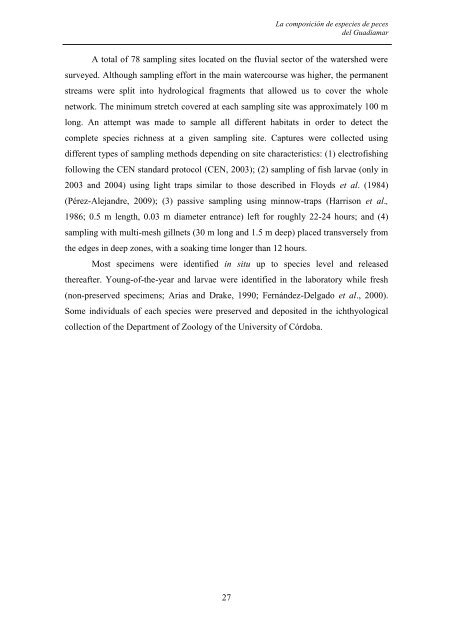las comunidades de peces del río guadiamar y el accidente minero ...
las comunidades de peces del río guadiamar y el accidente minero ...
las comunidades de peces del río guadiamar y el accidente minero ...
Create successful ePaper yourself
Turn your PDF publications into a flip-book with our unique Google optimized e-Paper software.
La composición <strong>de</strong> especies <strong>de</strong> <strong>peces</strong><br />
<strong>de</strong>l Guadiamar<br />
A total of 78 sampling sites located on the fluvial sector of the watershed were<br />
surveyed. Although sampling effort in the main watercourse was higher, the permanent<br />
streams were split into hydrological fragments that allowed us to cover the whole<br />
network. The minimum stretch covered at each sampling site was approximat<strong>el</strong>y 100 m<br />
long. An attempt was ma<strong>de</strong> to sample all different habitats in or<strong>de</strong>r to <strong>de</strong>tect the<br />
complete species richness at a given sampling site. Captures were collected using<br />
different types of sampling methods <strong>de</strong>pending on site characteristics: (1) <strong>el</strong>ectrofishing<br />
following the CEN standard protocol (CEN, 2003); (2) sampling of fish larvae (only in<br />
2003 and 2004) using light traps similar to those <strong>de</strong>scribed in Floyds et al. (1984)<br />
(Pérez-Alejandre, 2009); (3) passive sampling using minnow-traps (Harrison et al.,<br />
1986; 0.5 m length, 0.03 m diameter entrance) left for roughly 22-24 hours; and (4)<br />
sampling with multi-mesh gillnets (30 m long and 1.5 m <strong>de</strong>ep) placed transvers<strong>el</strong>y from<br />
the edges in <strong>de</strong>ep zones, with a soaking time longer than 12 hours.<br />
Most specimens were i<strong>de</strong>ntified in situ up to species lev<strong>el</strong> and r<strong>el</strong>eased<br />
thereafter. Young-of-the-year and larvae were i<strong>de</strong>ntified in the laboratory while fresh<br />
(non-preserved specimens; Arias and Drake, 1990; Fernán<strong>de</strong>z-D<strong>el</strong>gado et al., 2000).<br />
Some individuals of each species were preserved and <strong>de</strong>posited in the ichthyological<br />
collection of the Department of Zoology of the University of Córdoba.<br />
27

















